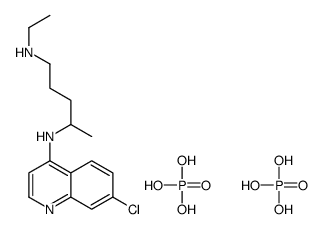Desethyl chloroquine diphosphate
Modify Date: 2025-08-25 19:53:06

Desethyl chloroquine diphosphate structure
|
Common Name | Desethyl chloroquine diphosphate | ||
|---|---|---|---|---|
| CAS Number | 247912-76-1 | Molecular Weight | 487.80900 | |
| Density | N/A | Boiling Point | N/A | |
| Molecular Formula | C16H28ClN3O8P2 | Melting Point | N/A | |
| MSDS | N/A | Flash Point | N/A | |
Use of Desethyl chloroquine diphosphateDesethyl chloroquine diphosphate is a major desethyl metabolite of Chloroquine. Chloroquine diphosphate is an inhibitor of autophagy and toll-like receptors (TLRs). Desethyl chloroquine diphosphate possesses antiplasmodic activity[1][2]. |
| Name | 4-N-(7-chloroquinolin-4-yl)-1-N-ethylpentane-1,4-diamine,phosphoric acid |
|---|---|
| Synonym | More Synonyms |
| Description | Desethyl chloroquine diphosphate is a major desethyl metabolite of Chloroquine. Chloroquine diphosphate is an inhibitor of autophagy and toll-like receptors (TLRs). Desethyl chloroquine diphosphate possesses antiplasmodic activity[1][2]. |
|---|---|
| Related Catalog | |
| Target |
P. falciparum[1] |
| In Vivo | Intraperitoneal injections of Chloroquine are administered to wild-type and Huntington's disease (Q175/Q175) mice. LC-MS/MS is used to compare the levels Chloroquine and its metabolites in blood, brain and muscle tissue. Concentrations of Chloroquine are lower (5-15M), but more stable in brain tissue compared to blood or muscle between 4 and 24 hours after the last dose. Levels of the active Chloroquine metabolite Desethyl chloroquine decreased in muscle and blood over the 24 hour post-injection period, while brain Desethyl chloroquine levels are lower and rose slightly over the same time frame[3]. |
| References |
| Molecular Formula | C16H28ClN3O8P2 |
|---|---|
| Molecular Weight | 487.80900 |
| Exact Mass | 487.10400 |
| PSA | 212.09000 |
| LogP | 2.68500 |
| InChIKey | PIKNKEKUPZTKFZ-UHFFFAOYSA-N |
| SMILES | CCNCCCC(C)Nc1ccnc2cc(Cl)ccc12.O=P(O)(O)O.O=P(O)(O)O |
| 1,4-Pentanediamine,N4-(7-chloro-4-quinolinyl)-N1-ethyl-,phosphate (1:2) |